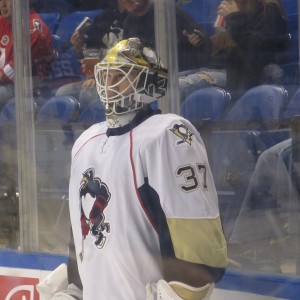
It wouldn’t be hockey season without an injury to an important player on the Pittsburgh Penguins.
Penguins GM Ray Shero announced on Saturday that goaltender Tomas Vokoun will be out indefinitely after undergoing a procedure to dissolve a blood clot in his pelvis. Vokoun remains in the hospital as Shero is waiting to decide how to fill the goaltending void.
“Indefinitely means indefinitely, so we’ll have to wait and see,” Shero said with regards to potential signings or roster moves. “As we move along here, we’ll have to make some determinations.”
Most teams wouldn’t notice the absence of their backup goaltender, but Vokoun has become a security blanket for Shero and the Penguins over the past 10 months. Starting goalie Marc-Andre Fleury’s troubles are well-documented and Vokoun single-handedly saved the Penguins from an embarrassing first round loss to the New York Islanders in last year’s playoffs.
Fleury hasn’t won over critics with his preseason play thus far. Shero and head coach Dan Bylsma both referred to his recent play as ‘OK’ — not exactly echoing the ringing endorsement Bylsma gave Fleury in his postseason comments last June.
So what happens next?
How Long Will Vokoun Be Out?
Shero tip-toed around most medical questions on Satuday, but the prognosis for Vokoun doesn’t look good.
Standard treatment for patients who experience this type of issue for the first time is anticoagulation therapy for three months. Playing hockey — and having pucks shot at you as a goaltender — is not feasible while on anticoagulants because of the risk of uncontrolled bleeding.
This also isn’t Vokoun’s first incident. Vokoun had blood clots in 2006 and was sidelined for close to four months. Shero said doctors told him the most recent situation was unrelated to 2006, but with the same issue in the same location, that’s tough to believe.
It’s not worth parsing words though. Shero made it a point to be vague for exactly that reason.
Indefinitely means indefinitely at this point. And that’s not good for the Penguins.
The New Backup

Jeff Zatkoff will take over for Vokoun for the time being.
Zatkoff, 26, is well-regarded around the league despite never receiving an NHL opportunity due to the stacked depth charts in Pittsburgh and Los Angeles. Bylsma even went as far as describing him as the best goalie in the American Hockey League last year.
“This is the opportunity I’ve been waiting for,” Zatkoff said on Sunday. “I’ve had five years of pro [hockey] now. I’ve been waiting for this for a long time.”
Zatkoff’s lack of experience is frightening in light of Fleury’s continued struggles. The Pensblog estimated that 22 points in the standings could be at risk if Vokoun were to miss the entire season.
Other Options
If the Penguins decide to look outside the organization, notable free agent names include Ilya Bryzgalov, Tim Thomas (on tryout with Florida), Johan Hedberg, Rick DiPietro, and Jose Theodore. Only Thomas is likely to be looking for more than the league minimum.
Hedberg is an intriguing name. His short history with the Penguins was legendary. He’s also respected around the league and familiar with the backup role. Hedberg was recently released from a tryout with the New York Rangers and is coming off a disappointing season, but still seems capable of handling 20 games as Fleury’s backup.
Trades are also an option. The possibilities there are too numerous to list but teams such as Edmonton and St. Louis will be forced to send talented goaltenders to the AHL to start the season.
Salary Cap Implications
The first order of business for Shero and Assistant GM Jason Botterill is getting their arms around the severity of Vokoun’s situation. If he’s expected to miss significant time, the Penguins will look to maximize their salary cap flexibility through use of the Long-Term Injury Exception (LTIR).
Three seasons ago the Penguins were faced with a similar issue as Jordan Staal was expected to miss significant time to start the 2010 season. Botterill orchestrated a complicated cap swap that saw promising prospect Eric Tangradi temporarily sent to Wheeling of the ECHL in order to maximize cap flexibility. [Click here for full details]
Here are the important items to keep in mind regarding Vokoun’s injury:
- Despite common misreporting, Vokoun’s salary will not “come off the books” while he is injured. It will continue to count against the Penguins’ cap totals regardless of how the rest of the roster shapes up. He also cannot be traded or demoted to the minor leagues.
- If Vokoun is placed on Injured Reserve, he will not count towards the team’s 23-man roster limit.
- The LTIR designation would require Vokoun to miss the first ten games of the regular season. He would be eligible to return October 26 against Toronto.
- LTIR simply allows the team to exceed the salary cap by a certain amount while the player is injured.
Prior to the Vokoun injury, the Penguins were expected to trim cap payroll in order to get under the $64.3 million salary cap ceiling. That’s not necessarily the case anymore.
LTIR relief to exceed the cap is calculated by taking the player’s salary and subtracting the available cap space at the time of the designation.
In English?
Tomas Vokoun carries a $2 million cap hit. If the Penguins have $1.5 million in cap space at the time of the LTIR designation, they are eligible for an extra $500k of relief. If they have $1 million in space, they get $1 million in relief. How about zero space? You guessed it — the full $2 million in cap relief. Therefore, Pittsburgh wants to be as close to the cap as possible before taking LTIR on Vokoun.
There are two paths the team could take with regards to Vokoun and the LTIR designation, keeping in mind their current 23-man lineup is approximately $1.1 million over the cap, including Vokoun.
1) Get Back to Zero: In the 2010 Staal situation, the team waited until the first day of the season to take the LTIR exception (read the article for further explanation). Botterill swapped Tangradi ($845k) for the lower-priced Patrick Killeen ($548k) on the opening day roster to get as close to the cap as possible without going over. This allowed them to maximize Staal’s $4 million LTIR space early in the season — a critical factor as injuries mounted in the weeks that followed.
In this case, the Penguins would need to eliminate $1.1 million (or about $1.6 million if you count Zatkoff’s inevitable promotion) from their roster for opening day through trades or demotions.
2) Get $2 Million Over: Teams can also take the LTIR option for their opening day roster. This would mean the Penguins want to increase their payroll so that they are exceeding the cap by Vokoun’s cap value. They could accomplish this through creative temporary swaps (as they did with Tangradi) as well as signing a new goalie or player such as Chuck Kobasew, who is currently with the Penguins on a tryout.
Either way, the Penguins would have to be cap compliant once again when Vokoun is ready to return. That would make the second option more challenging (and require midseason salary cuts) if Vokoun is not expected to miss the entire season.
There are a number of possibilities, but the Penguins are best served to wait until the last possible minute to make a decision.
Judging by the Penguins’ luck over the past few seasons, the injury to Vokoun might only be the beginning.
_________________________